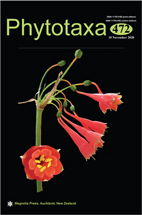Abstract
The tropical African genus Staudtia Warburg (1897a: 128) (Myristicaceae) is most often treated as consisting of two species, the widespread S. kamerunensis Warburg (1897a: 241) and the little-known S. pterocarpa Warburg (1897a: 243), the latter being endemic to the island of São Tomé (São Tomé and Príncipe, Gulf of Guinea). Staudtia pterocarpa has been known by the Portuguese common name Pau-Vermelho (vermelho meaning red), and the Santomean Portuguese names Vlêmê or Pó-Vlêmê, since at least the end of the 19th century (Negreiros 1895: 253). These common names are derived from the pressed bark that exudes a resinous red sap (Negreiros 1901: 85), this exudate being a characteristic feature of the family. The common names have also been explained as reflecting the colour of the timber. The core wood of the other species of Staudtia, S. kamerunensis, commonly known under the trade name Niove, could also take on an ochre-red colour [Phongphaew 2003: 142, as S. stipitata Warburg (1903: 384)]. At the beginning of the 20th century the timber of S. pterocarpa was considered excellent for construction and carpentry and the leaves were used medicinally (Negreiros 1901: 85). Presently the bark of S. pterocarpa is used in traditional medicine (Figueiredo et al. 2011). The species occurs in lowland forest up to ca. 1150 m above sea level and its conservation status is listed as Vulnerable (Oldfield et al. 1998, WCMC 1998).
References
<p class="Reference">Blume, C.L. (1835) <em>Rumphia, sive, Commentationes botanicæ imprimis de plantis Indiae Orientalis: tum penitus incognitis tum quæ in libris Rheedii, Rumphii, Roxburghii, Wallichii aliorum recensentur</em>. Volume 1. Lugduni Batavorum [Leiden, the Netherlands], C.G. Sulpke, H. Remy, Arnz et socios, G. Roret, 204 pp.</p><p class="Reference"> <a href="https://doi.org/10.5962/bhl.title.51502">https://doi.org/10.5962/bhl.title.51502</a></p><p class="Reference">Christy, T. (1885) Nutmeg genus. <em>New Commercial Plants and Drug</em> 8: 26–31.<em></em></p><p class="Reference">Exell, A.W. (1944) <em>Catalogue of the vascular plants of S.Tomé (with Príncipe and Annobon)</em>. British Museum (Natural History), London, 428 pp.</p><p class="Reference">Exell, A.W. (1973) Angiosperms of the islands of the Gulf of Guinea (Fernando Po, Príncipe, S.Tomé and Annobon). <em>Bulletin of the British Museum (Natural History) Botany</em> 4 (8): 327–411.</p><p class="Reference">Figueiredo, E. (1994) Little known endemics collected by J. Espírito Santo in S.Tomé. <em>Garcia de Orta. Série de botânica</em> 12 (1 & 2): 121–124.</p><p class="Reference">Figueiredo, E., Paiva, J., Stévart, T., Oliveira, F. & Smith, G.F. (2011) An annotated catalogue of the flowering plants of São Tomé and Príncipe. <em>Bothalia</em> 41 (1): 41–82.</p><p class="Reference"> <a href="https://doi.org/10.4102/abc.v41i1.34">https://doi.org/10.4102/abc.v41i1.34</a></p><p class="Reference">Figueiredo, E. & Smith, G.F. (2020a) Friedrich Welwitsch and his contributions to the exploration and study of the flora of São Tomé and Príncipe, Gulf of Guinea, with typification of three names described from his collections. <em>Phytotaxa</em> 459 (3): 227–234.</p><p class="Reference"> <a href="https://doi.org/10.11646/phytotaxa.459.3.4">https://doi.org/10.11646/phytotaxa.459.3.4</a></p><p class="Reference">Figueiredo, E. & Smith, G.F. (2020b) Typification of <em>Euphorbia candelabrum</em> (Euphorbiaceae) and associated names. <em>Phytotaxa</em> 447 (3): 216–220.</p><p class="Reference"> <a href="https://doi.org/10.11646/phytotaxa.447.3.8">https://doi.org/10.11646/phytotaxa.447.3.8</a></p><p class="Reference">Hiern, W.P. (1900) <em>Catalogue of the African plants collected by Dr Friedrich Welwitsch in 1853–61, Dicotyledons, Part IV</em>. Printed by order of the Trustees [of the British Museum], London. [785<em>–</em>]1035 pp. [https://www.biodiversitylibrary.org/item/42452#page/5/mode/1up]</p><p class="Reference">Murray, G. (1896) Preface. <em>In</em>: Hiern, W.P. (Ed.) <em>Catalogue of the African plants collected by Dr Friedrich Welwitsch in 1853–61, Dicotyledons</em>, Part I. Printed by order of the Trustees [of the British Museum], London, pp. v–vi. [https://www.biodiversitylibrary.org/item/42462#page/11/mode/1up]</p><p class="Reference">Museum entry book, Kew. (1861–1879) <em>Museum entry book</em>. Royal Botanic Gardens, Kew. Richmond, Surrey, 572 pp. [https://www.biodiversitylibrary.org/item/274452#page/9/mode/1up]</p><p class="Reference">Negreiros, A.A. (1895) <em>Historia ethnographica da ilha de S.Thomé</em>. Antiga Casa Bertrand, José Bastos, Lisboa, 369 pp.</p><p class="Reference">Negreiros, A.A. (1901) <em>Notice historico-économique de l’île de San-Thomé et monographie des produits envoyés par cette colonie à l’Exposition Universelle de Paris de 1900</em>. Augustin Challamel, Paris, 166 pp.</p><p class="Reference">Oldfield, S., Lusty, C. & MacKinven, A. (Eds.) (1998) <em>The World List of Threatened Trees</em>. World Conservation Monitoring Centre, World Conservation Press, Cambridge, 650 pp.</p><p class="Reference">Phongphaew, P. (2003) <em>The commercial woods of Africa. A descriptive, full-colour guide</em>. Linden Publishing Co., Inc., Fresno, California, 206 pp.</p><p class="Reference">Rottbøll, C.F. (1778) Descriptiones Plantarum Surinamensium. <em>Acta Literaria Universitatis Hafniensis </em>1: 269–304. [https://babel.hathitrust.org/cgi/pt?id=hvd.32044089221154&view=1up&seq=287]</p><p class="Reference">Smith, G.F. & Figueiredo, E. (2020) Typification of the name <em>Kalanchoe scapigera</em> (Crassulaceae subfam. Kalanchooideae). <em>Phytotaxa</em> 435 (2): 203–207.</p><p class="Reference"> <a href="https://doi.org/10.11646/phytotaxa.435.2.7">https://doi.org/10.11646/phytotaxa.435.2.7</a></p><p class="Reference">Stafleu, F.A. & Cowan, R.S. (1988) <em>Taxonomic literature: a selective guide to botanical publications and collections with dates, commentaries and types</em>. Vol. 7: W–Z. 2nd edn. Bohn, Scheltema & Holkema; dr. W. Junk b.v., Publishers, Utrecht/Antwerpen & The Hague/Boston, 653 pp. [https://www.biodiversitylibrary.org/item/103250#page/7/mode/1up]</p><p class="Reference">Stapf, O. (1909) Myristicaceae. <em>In</em>: Thiselton-Dyer, W.T. (Ed.) <em>Flora of Tropical Africa</em>, Vol. 6(1). L. Reeve & Co., London, pp. 156–167. [https://www.biodiversitylibrary.org/item/129#page/168/mode/1up]</p><p class="Reference">Turland, N.J., Wiersema, J.H., Barrie, F.R., Greuter, W., Hawksworth, D.L., Herendeen, P.S., Knapp, S., Kusber, W.-H., Li, D.-Z., Marhold, K., May, T.W., McNeill, J., Monro, A.M., Prado, J., Price, M.J. & Smith, G.F. (2018) International Code of Nomenclature for algae, fungi, and plants (Shenzhen Code) adopted by the Nineteenth International Botanical Congress Shenzhen, China, July 2017. <em>Regnum Vegetabile</em> 159. Koeltz Botanical Books, Glashütten.</p><p class="Reference"> <a href="https://doi.org/10.12705/Code.2018">https://doi.org/10.12705/Code.2018</a></p><p class="Reference">Warburg, O. (1895) Myristicaceae. <em>In</em>: Engler, A. (Ed.) <em>Die Pflanzenwelt Ost-Afrikas und der Nachbargebiete</em>. <em>Theil C.</em> Dietrich Reimer, Berlin, pp. 179–180. [https://www.biodiversitylibrary.org/item/10523#page/184/mode/1up]</p><p class="Reference">Warburg, O. (1896) Zur Charakterisirung und Gliederung der Myristicaceen. <em>Berichte der Deutschen Botanischen Gesellschaft</em> 13: 82–95. [https://www.biodiversitylibrary.org/item/132451#page/686/mode/1up]</p><p class="Reference">Warburg, O. (1897a) Monographie der Myristicaceen. <em>Nova acta Academiae Caesareae Leopoldino-Carolinae Germanicae Naturae Curiosorum</em> 68: 1–680. [https://www.biodiversitylibrary.org/item/45222#page/13/mode/1up]</p><p class="Reference">Warburg, O. (1897b) <em>Die Muskatnuss ihre Geschichte, Botanik, Kultur, Handel und Verwerthung sowie ihre Verfälschungen und Surrogate. Zugleich ein Beitrag zur Kulturgeschichte der Banda-Inseln</em>. W. Engelmann, Leipzig, 628 pp.</p><p class="Reference"> <a href="https://doi.org/10.5962/bhl.title.15403">https://doi.org/10.5962/bhl.title.15403</a></p><p class="Reference">Warburg, O. (1903) Myristicaceae africanae. <em>Botanische Jahrbücher fur Systematik, Pflanzengeschichte und Pflanzengeographie</em> 33: 382–384. [https://www.biodiversitylibrary.org/page/213193#page/393/mode/1up]</p><p class="Reference">WCMC (World Conservation Monitoring Centre) (1998) <em>Staudtia pterocarpa</em>. The IUCN Red List of Threatened Species 1998: e.T32780A9723570.</p><p> <a href="https://dx.doi.org/10.2305/IUCN.UK.1998.RLTS.T32780A9723570.en">https://dx.doi.org/10.2305/IUCN.UK.1998.RLTS.T32780A9723570.en</a></p>

